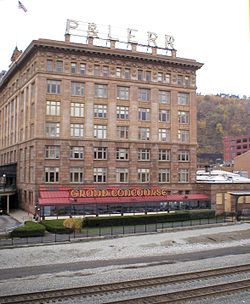Station Square
Pittsburgh & Lake Erie Railroad Complex | |
 The P&LE Railroad Station at Station Square | |
| Location | Smithfield and Carson Sts., Pittsburgh, Pennsylvania |
|---|---|
| Coordinates | 40°26′6″N 80°0′27″W / 40.43500°N 80.00750°W |
| Area | 52 acres (21 ha) |
| Built | 1897 |
| Architect | Pittsburgh & Lake Erie Railroad |
| NRHP reference No. | 79002161[1] |
| Added to NRHP | December 31, 1979 |
Station Square is a 52-acre (210,000 m2) indoor and outdoor shopping and entertainment complex located in the South Shore neighborhood of Pittsburgh, Pennsylvania, United States across the Monongahela River from the Golden Triangle of downtown Pittsburgh. Station Square occupies the buildings and land formerly occupied by the historic Pittsburgh & Lake Erie Railroad Complex, including the Pittsburgh & Lake Erie Railroad Station, which are separately listed on the National Register of Historic Places.[2]
With 275,000 square feet (25,500 m2) of retail space, it features nearly 60 stores, restaurants and entertainment venues, including Highmark Stadium and the 396-room Sheraton at Station Square. As one of Pittsburgh’s largest tourist destinations, it attracts more than three million people annually, including many Pittsburgh natives. The retail development was built at the location of a former station on the Pittsburgh and Lake Erie Railroad, with many of the original structures such as the freight house building and the concourse being converted into restaurants and a shopping mall. Proximity to a stop on the Port Authority of Allegheny County 'T' Pittsburgh Light Railsystem, and the dock for the Gateway Clipper Fleet of local river cruise boats makes Station Square a major parking and jumping-off point for activities and events around the city. The property is operated by Cleveland-based Forest City Enterprises.
In 1979, the Station Square complex was listed on the National Register of Historic Places as the "Pittsburgh & Lake Erie Railroad Complex."[1]
History

Station Square was conceptualized by Arthur P. Ziegler, Jr., one of the founding national leaders of historic preservation in the United States, and President of the Pittsburgh History and Landmarks Foundation, or Landmarks. Landmarks developed the site in 1976 as a mixed-use historic adaptive reuse development that gave the foundation the opportunity to put its urban planning principles into practice.

Aided by an initial gift from the Allegheny Foundation in 1976, Landmarks adapted five historic Pittsburgh and Lake Erie Railroad buildings for new uses and added a hotel, a dock for the Gateway Clipper Fleet, and parking areas. Now shops, offices, restaurants and entertainment anchor the historic riverfront site on the south shore of the Monongahela River, opposite the Golden Triangle (Pittsburgh). It reflects a $100 million investment from all sources, with the lowest public cost and highest taxpayer return of any major renewal project in the Pittsburgh region since the 1950s. In 1994, Pittsburgh History and Landmarks Foundation sold Station Square to Cleveland owned Forest City Enterprises which created an endowment to help support its restoration efforts and educational programs. Each year the staff and docents of Pittsburgh History and Landmarks Foundation introduce more than 10,000 people — teachers, students, adults and visitors — to the architectural heritage of the Pittsburgh region and to the value of historic preservation.[3]
See also
References
- ^ a b "National Register Information System". National Register of Historic Places. National Park Service. March 13, 2009.
- ^ Smith, Eliza. "Pittsburgh & Lake Erie Railroad Complex" (PDF). National Register of Historical Places Nomination Form. Pennsylvania Historical and Museum Commission. Retrieved January 23, 2014.
- ^ "History". StationSquare.com. Retrieved January 23, 2014.
External links
- Railway stations on the National Register of Historic Places in Pennsylvania
- Transport infrastructure completed in 1897
- Pittsburgh and Lake Erie Railroad
- Forest City Enterprises
- Visitor attractions in Pittsburgh
- Entertainment districts in the United States
- Shopping districts and streets in the United States
- Economy of Pittsburgh
- Redeveloped ports and waterfronts in the United States
- 1976 establishments in Pennsylvania
- Buildings and structures in Pittsburgh
- National Register of Historic Places in Pittsburgh





